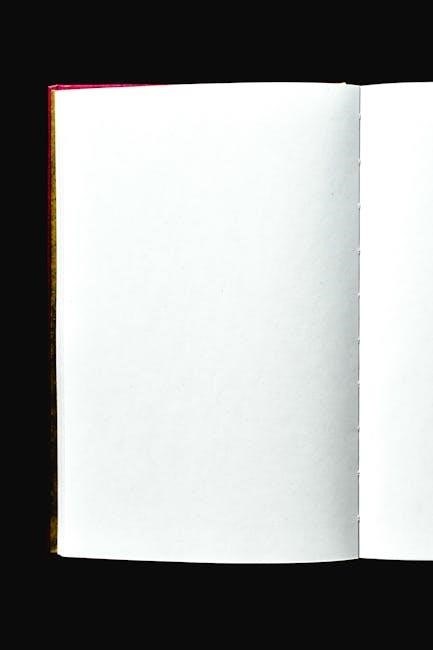Anne Frank’s diary, written during WWII, is a poignant account of hope and resilience. Available in PDF, it offers a convenient way to explore this historic document, ensuring Anne’s story reaches global audiences, fostering empathy and understanding of the Holocaust’s impact.
1.1 Brief Overview of Anne Frank’s Diary
Anne Frank’s diary is a deeply personal and emotional account of her life in hiding during WWII. Written between 1942 and 1944, it captures her daily struggles, hopes, and fears. The diary, available in PDF format, offers a vivid portrayal of her family’s secret life in Amsterdam. It is a powerful narrative of resilience, love, and the human spirit, providing an intimate glimpse into one of history’s darkest periods.
1.2 Historical Context of the Diary
The diary is set against the backdrop of WWII, when Anne Frank and her family fled Nazi persecution in Amsterdam. The PDF version of her diary reveals the harsh realities of Jewish life under occupation. From 1942 to 1944, Anne documented their confinement in the Secret Annex, offering a unique perspective on the Holocaust. This historical context underscores the diary’s significance as a firsthand account of one of humanity’s darkest hours.
1.3 Importance of the Diary as a Historical Document
Anne Frank’s diary is a vital historical document, offering a personal and poignant account of life during the Holocaust. Its PDF format ensures accessibility, preserving the raw emotions and experiences of a young girl under Nazi oppression. The diary humanizes the victims of WWII, providing an intimate perspective on persecution and resilience. As a historical text, it serves as a powerful educational tool, fostering empathy and understanding of one of history’s darkest chapters.

The Diary’s Structure and Content
The diary, written from 1942 to 1944, includes original entries and revisions, offering a deeply personal account of Anne’s life in hiding. The PDF version provides a comprehensive view of her thoughts, emotions, and experiences during WWII, making it an invaluable historical and literary resource.
2.1 The Original Diary and Its Revisions
Anne Frank maintained two versions of her diary. The original journal, started in 1942, was later revised with pseudonyms and expanded entries. The revised version, known as the “b” version, was prepared for potential publication. Both versions are included in the definitive edition, offering insights into Anne’s growth as a writer and her reflections on life in hiding. The PDF format preserves the integrity of these texts, allowing readers to explore Anne’s evolving narrative seamlessly.
2.2 Key Themes and Topics in the Diary
The diary explores themes of hope, resilience, and identity, offering a deeply personal perspective on life under Nazi occupation. Anne writes about her daily struggles, relationships, and aspirations, while reflecting on the humanity of those around her. The diary also delves into the emotional and moral challenges of living in hiding, providing a unique lens on the Holocaust. These themes, preserved in the PDF format, continue to resonate with readers, making the diary a timeless and universal work.
2.3 The Use of Pseudonyms in the Diary
Anne Frank used pseudonyms in her diary to protect the identities of those who helped her family while in hiding. This practice, evident in the PDF versions of her diary, reflects her awareness of the risks faced by her helpers. The pseudonyms added a layer of secrecy, ensuring their safety while preserving the diary’s authenticity. This literary device allows readers to connect with the characters while respecting their anonymity, making the diary both personal and universal in its appeal.

The Publication and Editions of the Diary
The diary was first published in 1947, with later editions revealing more of Anne’s writings. The PDF version ensures accessibility, preserving her story for global readers.
3.1 The First Publication in 1947
The diary was first published in 1947, edited by Anne’s father, Otto Frank. This initial release introduced the world to Anne’s poignant story, capturing the essence of her experiences during WWII. The PDF version of this edition is widely available, allowing readers to access the original narrative that has become a cornerstone of Holocaust literature. Its publication marked the beginning of Anne Frank’s legacy, ensuring her voice would be heard globally.
3.2 The Definitive Edition of the Diary
The Definitive Edition, approved by the Anne Frank-Fonds, includes 30% more material than the original, offering deeper insights into Anne’s life and thoughts. This version, available in PDF, provides readers with a comprehensive understanding of her experiences during WWII. It preserves the authenticity of her narrative while expanding on her reflections, making it a vital resource for those seeking a fuller connection to her story and legacy.
3.4 The Critical Edition and Its Significance
The Critical Edition of Anne Frank’s diary provides a scholarly perspective, featuring the original diary, its revised version, and historical context. This edition, available in PDF, includes annotations and essays that enhance understanding of Anne’s experiences. It serves as an invaluable resource for researchers and educators, providing insights into the Holocaust and Anne’s literary legacy. Its detailed analysis and comprehensive approach make it essential for academic studies.

The Impact and Legacy of the Diary
Anne Frank’s diary has become a global symbol of Holocaust education, inspiring awareness and empathy. Its availability in PDF ensures widespread accessibility, preserving its enduring legacy.
4.1 The Diary’s Popularity and Translations
The Diary of a Young Girl has become a global phenomenon, translated into over 70 languages. Its universal themes of hope and resilience resonate worldwide. The diary’s popularity soared after its publication in 1947, making it one of the most widely read books of the 20th century. Digital versions, including PDF formats, have further expanded its reach, ensuring Anne Frank’s story remains accessible to new generations. Its enduring appeal lies in its raw honesty and timeless relevance.
4.2 The Diary’s Role in Holocaust Education
The Diary of a Young Girl is a crucial educational resource in Holocaust studies. Its personal narrative offers a relatable perspective on life under Nazi occupation, making the Holocaust tangible for students. Widely incorporated into school curricula, the diary’s emotional depth fosters empathy and understanding. Available in PDF, it’s easily accessible for educational use, facilitating its integration into various teaching methods. This accessibility ensures the diary remains a central text in Holocaust education globally.
4.3 Adaptations and Interpretations of the Diary
The Diary of a Young Girl has inspired numerous adaptations, including the 1955 play and 1959 film, widening its reach. Its universal themes have led to interpretations in various formats, such as educational resources and digital adaptations. The diary’s availability in PDF has further facilitated its use in study guides and multimedia projects, like the Anne Frank Video Diary on YouTube, ensuring its message continues to resonate across generations and educational platforms.

The Themes and Style of the Diary
Anne Frank’s diary explores themes of hope, resilience, and identity, blending youthful innocence with profound reflections. Its literary style, marked by vivid storytelling and emotional depth, captivates readers, making it a timeless and deeply human document.
5.1 The Theme of Hope and Resilience
Anne Frank’s diary is a powerful exploration of hope and resilience amidst unimaginable adversity. Despite the confinement and fear of discovery, Anne consistently expresses optimism, dreaming of a better future and clinging to her belief in humanity’s goodness. Her writings reveal a deep inner strength, as she navigates the challenges of adolescence under oppressive circumstances, offering a poignant reminder of the human spirit’s capacity to endure and remain hopeful in the face of despair.
5.2 The Exploration of Identity in the Diary
Anne Frank’s diary is a profound exploration of her evolving identity. As she navigates adolescence in hiding, Anne grapples with her Jewish heritage, intellectual aspirations, and emotional struggles. Her writings reflect a deep self-awareness, revealing her growth from a young girl into a thoughtful, compassionate individual; The diary serves as a mirror of her inner world, capturing her quest for self-discovery and understanding amidst the turmoil of war and confinement.
5.3 The Literary Style and Narrative Techniques
Anne Frank’s diary showcases a unique literary style, blending honesty with vivid storytelling. Her narrative techniques, such as detailed descriptions and emotional reflections, create an intimate connection with readers. The use of pseudonyms adds depth, while her revisions reveal her growth as a writer. The diary’s conversational tone makes it relatable, offering insights into her inner world and the harsh realities of her circumstances.

The Educational Significance of the Diary
The diary is a vital educational tool, teaching students about the Holocaust and fostering empathy. Its inclusion in school curricula promotes historical understanding and literary analysis, encouraging critical thinking and reflection on humanity’s resilience.
6.1 The Diary in School Curricula
The Diary of Anne Frank is widely incorporated into school curricula worldwide, serving as a vital resource for Holocaust education. Teachers use the diary to teach empathy, historical context, and literacy skills. Its inclusion in educational programs fosters critical thinking and promotes cross-cultural understanding. The diary’s availability in PDF format makes it easily accessible for classroom use, enabling students to engage deeply with Anne’s story and its universal themes of hope and resilience.
6.2 Teaching the Diary as a Literary and Historical Text
The Diary of Anne Frank is a dual educational tool, offering insights into both literature and history. Educators use it to teach narrative techniques, thematic analysis, and historical context. The diary’s personal perspective on the Holocaust makes it a powerful resource for understanding the human experience during WWII. Teachers often pair the text with guided readings, discussions, and reflective writing to deepen comprehension. Its availability in PDF format enhances accessibility, allowing for easy integration into lesson plans and fostering a deeper connection to Anne’s story.
6.3 Student Responses and Engagement with the Diary
Students often deeply connect with Anne Frank’s diary, finding her experiences and emotions relatable. The diary’s universal themes of hope, identity, and family resonate strongly. Many students express empathy for Anne’s plight, fostering a deeper understanding of the Holocaust. The availability of the diary in PDF format makes it accessible for classroom use, enabling interactive lessons and discussions. This engagement helps students develop critical thinking and emotional intelligence while exploring historical and literary contexts.

Accessing the Diary in PDF Format
Anne Frank’s diary is widely available in PDF format, offering easy access to her profound story. Readers can download it from various online platforms, ensuring its timeless message reaches global audiences effortlessly, while preserving its historical and emotional significance for future generations.
7.1 Sources for Downloading the Diary as a PDF
The diary can be downloaded in PDF format from various online platforms, including the Internet Archive, Google Books, and LitRes. These sources offer free or paid options, ensuring accessibility for readers worldwide. Additionally, websites like PDF Drive and eBook platforms provide direct links to download the diary, often accompanied by supplementary materials such as timelines and biographies, enhancing the reader’s understanding of Anne Frank’s story and its historical context.
7.2 Reading the Diary on Digital Platforms
The diary is widely accessible on e-readers and reading apps, such as Kindle, Kobo, and Apple Books. Platforms like LitRes and Internet Archive offer digital versions, enabling readers to access the diary on tablets, iPads, and smartphones. Features like adjustable font sizes and night mode enhance readability. This convenience ensures Anne Frank’s story remains relevant and easily accessible for new generations, fostering a deeper connection with her experiences and perspectives during WWII.
7.3 The Convenience of the PDF Format
The PDF format offers unparalleled convenience for readers of Anne Frank’s diary. It allows easy access on various devices, such as smartphones, tablets, and computers, without requiring physical storage. The diary can be downloaded and carried anywhere, enabling readers to engage with Anne’s story anytime. PDFs also support features like search, zoom, and bookmarking, enhancing readability. Additionally, the format preserves the diary’s original layout and content, making it a reliable and portable way to experience this historic document.

The Frank Family and Their Story
The Frank family, originally from Frankfurt, relocated to Amsterdam to escape Nazi persecution. Otto Frank, Anne’s father, sought a safer life for his family, including daughters Anne and Margot.
8.1 The Frank Family’s Background and History
The Frank family, originally from Frankfurt, Germany, relocated to Amsterdam in the early 1930s to escape rising Nazi tensions. Otto Frank, a businessman, sought a safer environment for his wife, Edith, and their daughters, Anne and Margot. They established a stable life in Amsterdam, where Otto ran a successful spice business. The family’s background reflects a typical Jewish household striving for normalcy amidst growing political unrest in Europe.
8.2 The Secret Annex and Life in Hiding
The Frank family moved into the Secret Annex above Otto Frank’s office in Amsterdam in 1942. They were joined by four others, living in cramped conditions. The group relied on loyal helpers like Miep Gies for supplies. Anne documented their daily struggles, hopes, and tensions in her diary. Despite the confinement, she found solace in writing, reflecting on her inner world and aspirations. Life in hiding was precarious, yet Anne’s diary became her sanctuary.
8.3 The Discovery and Aftermath of the Secret Annex
In August 1944, the Secret Annex was discovered by the Nazis, leading to the arrest of the Frank family and others in hiding. Anne and her sister Margot were deported to Bergen-Belsen, where they died in early 1945. Otto Frank, Anne’s father, survived and returned to Amsterdam, where he dedicated his life to sharing Anne’s diary. The discovery marked a tragic end to their hiding and a poignant beginning to the diary’s journey as a historical testament.

The Role of Miep Gies and Other Helpers
Miep Gies played a crucial role in preserving Anne Frank’s diary after the Secret Annex was discovered. She bravely retrieved the diary, ensuring its survival and historical significance.
9.1 Miep Gies and Her Role in Preserving the Diary
Miep Gies, a close family friend, played a pivotal role in preserving Anne Frank’s diary. After the Secret Annex was discovered, she courageously retrieved the diary, ensuring its survival. Her bravery and loyalty were instrumental in safeguarding the document, which became a vital historical record of the Holocaust. Miep’s actions exemplify the selflessness of those who risked everything to protect the Frank family and their legacy.
9.2 The Helpers Who Assisted the Frank Family
The helpers, including Jan Kraler and others, risked their lives to support the Frank family. They provided essential supplies and maintained the secrecy of the Annex. Their bravery and selflessness were vital for the family’s survival during their time in hiding; These individuals, often unsung heroes, demonstrated extraordinary courage in the face of Nazi oppression, ensuring the family’s needs were met despite the constant danger they faced every day.
9.3 The Significance of Their Bravery and Sacrifice
The bravery of Miep Gies and other helpers who assisted the Frank family is immeasurable. Their selfless acts of providing food, supplies, and emotional support ensured the family’s survival in hiding. These individuals risked their lives daily, embodying extraordinary moral courage. Their sacrifices not only preserved Anne’s diary but also allowed her story to become a powerful symbol of hope and resilience, educating future generations about the Holocaust and the importance of standing against oppression.

The Diary’s Place in Holocaust Literature
Anne Frank’s diary stands as a seminal work in Holocaust literature, offering a deeply personal and poignant perspective on life under Nazi occupation, resonating universally.
10.1 Comparisons with Other Holocaust Diaries
Anne Frank’s diary is often compared to other Holocaust diaries for its unique voice and perspective. While works like Viktor Frankl’s Man’s Search for Meaning and Elie Wiesel’s Night provide profound insights into the Holocaust, Anne’s diary stands out for its intimate, personal narrative. Her reflections on hope, identity, and daily life in hiding offer a distinct lens through which to understand the Holocaust’s impact on individuals and families. This personal touch makes her diary one of the most relatable and enduring accounts of the period.
10.2 The Diary’s Unique Perspective on the Holocaust
Anne Frank’s diary offers a deeply personal and emotional perspective on the Holocaust, capturing the daily struggles and hopes of a young girl in hiding. Unlike other accounts, Anne’s diary provides an intimate, relatable voice, blending adolescence with the harsh realities of war. Its unique blend of personal reflections and historical context makes it a powerful tool for understanding the Holocaust’s impact on individuals and families, resonating universally and fostering empathy and awareness.
10.3 The Diary’s Impact on Holocaust Awareness
Anne Frank’s diary has profoundly shaped Holocaust awareness, offering a deeply personal and relatable account of life under Nazi oppression. Its widespread availability in PDF format has made it accessible to millions, educating readers worldwide about the Holocaust’s atrocities. The diary humanizes victims, fostering empathy and understanding. It serves as a powerful tool against Holocaust denial, providing irrefutable evidence of the regime’s brutality. Its impact continues to inspire global efforts to combat prejudice and promote tolerance.
Anne Frank’s Legacy and Memory
Anne Frank’s legacy endures as a symbol of hope and resilience. The Anne Frank House Museum and Foundation preserve her story, promoting peace and human rights globally.
11.1 The Establishment of the Anne Frank House Museum
The Anne Frank House Museum, located in Amsterdam, was established to preserve the Secret Annex where Anne and her family hid. The museum showcases the original hiding place, artifacts, and excerpts from Anne’s diary, offering a poignant glimpse into her life during WWII. It serves as a powerful educational resource, attracting millions of visitors annually and honoring Anne’s legacy by promoting tolerance and understanding of the Holocaust’s impact.
11.2 The Anne Frank Foundation and Its Work
The Anne Frank Foundation, established by Otto Frank, works to promote Anne’s legacy and message of tolerance. It supports educational programs, exhibitions, and projects worldwide, focusing on human rights and combating prejudice. The foundation also manages the copyright of Anne’s writings, ensuring her diary remains accessible, including in PDF formats, to educate future generations about the Holocaust and inspire global understanding of its impact.
11.3 Anne Frank’s Enduring Symbolic Importance
Anne Frank has become a universal symbol of hope, resilience, and the human spirit. Her diary, widely available in PDF, serves as a powerful educational tool, inspiring global understanding of the Holocaust. As a representative of millions of victims, Anne’s story transcends time, fostering empathy and promoting tolerance. Her legacy continues to educate future generations, ensuring her message of peace and humanity endures, making her one of the most significant figures of the 20th century.
